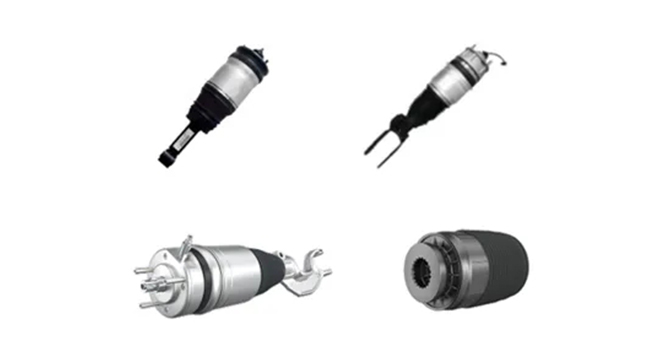On the road of pursuing ultimate comfort and handling in the modern automotive industry, air spring technology is becoming the core of high-end suspension systems with its unique advantages. This innovative design using compressed air as the elastic medium is completely changing our understanding and application of vehicle shock absorption systems.

Working principle and structural layout of air spring system
Air spring is essentially a pneumatic elastic component that uses compressed air as the working medium. When the vehicle is driving, the internal air pressure of the airbag will dynamically change according to the road conditions. Through the compressibility of air, the mechanical vibration energy is converted into the compression and expansion process of gas, thereby achieving excellent shock absorption effect.
In a typical vehicle layout, the air spring system adopts a differentiated design:
Front suspension: The air spring and shock absorber adopt an integrated design, forming a compact suspension assembly that saves space and improves response speed
Rear suspension: Air springs and shock absorbers are arranged separately, which facilitates load adjustment and is particularly suitable for SUVs and luxury models with variable load requirements
The three core technological advantages of air springs
1. Intelligent height adjustment system
The most significant feature of an air spring is its ability to automatically adjust the body height based on the vehicle's load status
Heavy load condition: Automatically inflate and raise the vehicle body, maintain sufficient ground clearance, and avoid chassis scratches
Empty state: Reduce the vehicle height appropriately, optimize aerodynamic performance, and improve high-speed driving stability
Special mode: Some high-end models can also achieve welcome mode (lowering the body for easy boarding and alighting when parking) or off-road mode (increasing the chassis height to enhance passability)
2. Dynamic stiffness adjustment function
Unlike the fixed stiffness of traditional steel springs, air springs have achieved revolutionary variable stiffness characteristics:
High stiffness mode: By increasing air pressure to enhance support, it effectively suppresses body roll and enhances handling during high-speed cornering
Low stiffness mode: reduces air pressure to make the suspension softer, providing excellent shock absorption performance on urban or bumpy roads
Adaptive adjustment: Advanced systems can perceive road conditions and driving styles in real time, automatically finding the optimal balance point for stiffness
3. Excellent shock absorption performance
The damping mechanism of air springs has brought a qualitative leap:
High energy conversion efficiency: converts road impact into compression work of air inside the airbag, with an energy absorption rate of over 85%
Significant vibration attenuation: Compared to traditional suspension, it can reduce the vibration transmitted to the vehicle body by 30-50%
Excellent noise control: In complex road conditions such as rural roads, the noise inside the car can be reduced by 3-5 decibels
Low fatigue damage: significantly reduces the cumulative damage of vibration to the vehicle structure and extends the service life of the vehicle
Technology Application and Development Trends
At present, air spring technology has gradually expanded from the initial commercial vehicle field to the high-end passenger car market. Flagship models such as Mercedes Benz S-Class and Audi A8 come standard with it, while some new energy brands also incorporate it as an important component of their intelligent chassis systems.
Future development trends include:
Intelligent integration: Deep integration with vehicle mounted sensor networks to achieve millisecond level response
Energy Recovery: Research on the Technology of Converting Suspension Vibration Energy into Electrical Energy Storage
Lightweight design: using new composite materials to reduce system weight
Cost optimization: Reduce manufacturing costs through large-scale production and penetrate into the mid-range market
Air spring technology is redefining the performance boundaries of vehicle suspension systems, representing not only the highest level of current chassis technology, but also opening up new possibilities for future intelligent travel experiences. With the continuous advancement of technology and cost optimization, this configuration, which was once exclusive to luxury cars, is expected to become a standard equipment for the next generation of cars.

